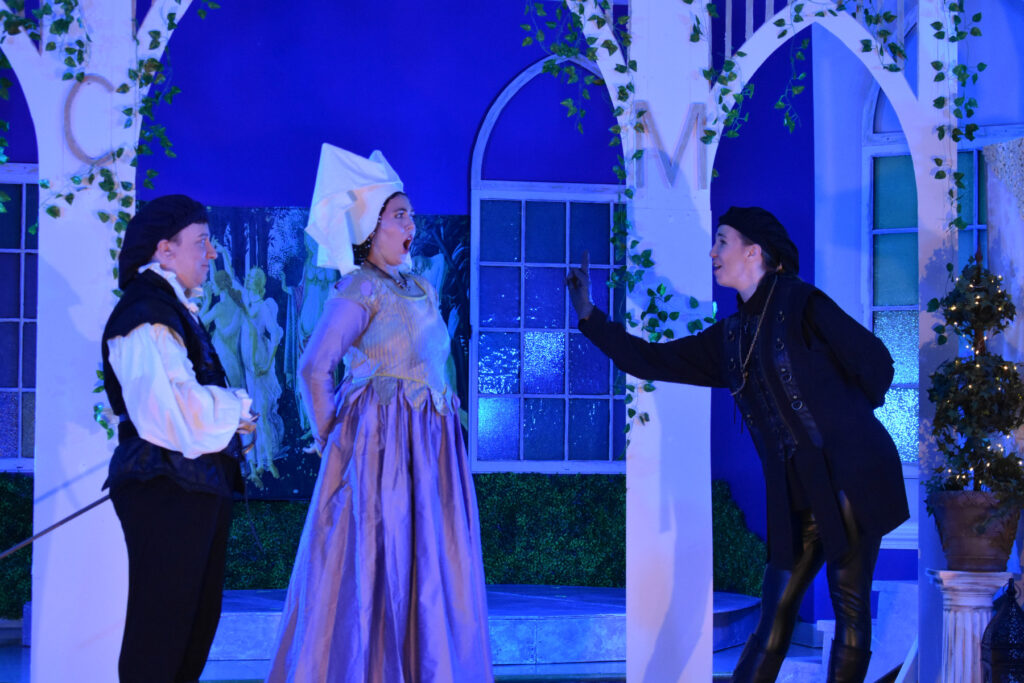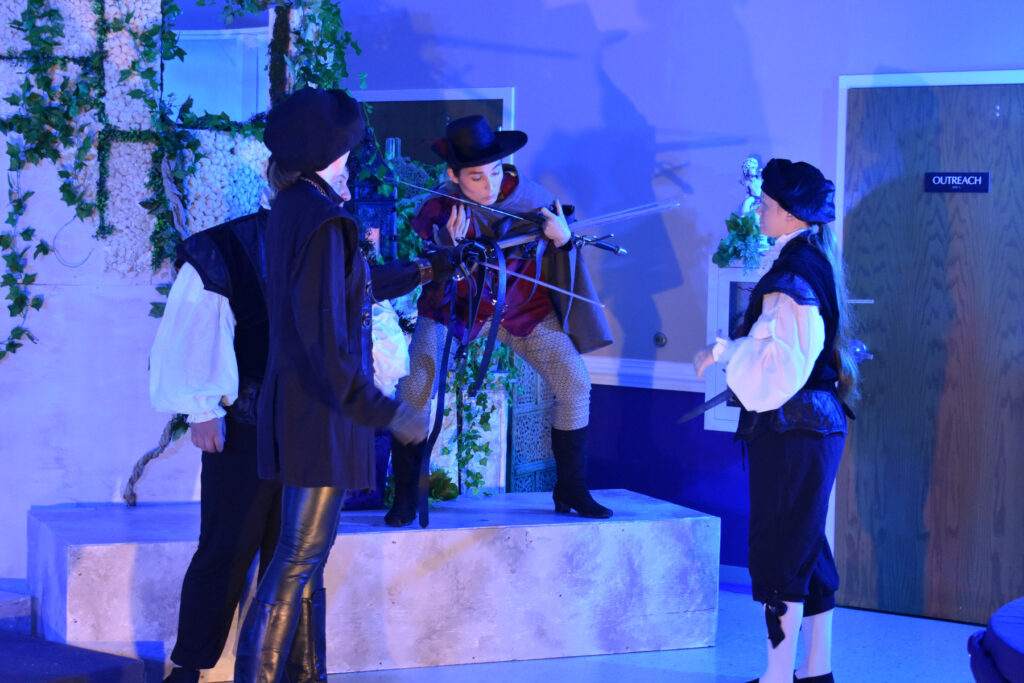Over the past ten years, Shakespeare Opera Theatre has made a name for itself by combining Shakespeare’s plays with operatic adaptations of his work. Managing director Dr. Lori Lind’s encyclopedic knowledge and understanding of both allows her to create cuts in script and score that make sense, and this production that combines Gounod’s music with Shakespeare’s text exemplifies a successful joining of the two.
Before the show even begins, one is struck by the sumptuous set, designed by Dr. Lind herself. The largest the company has yet used, it includes two towers complete with stone detail work, a fountain, and assorted plants that function as both something one might see walking the streets of Verona, and also Friar Lawrence’s garden. As such, I definitely felt immersed in the world of the story. And, the walls of the set provided for better stage masking than in some previous productions, where you might see actors getting into place. Combine that with set changes that were accompanied by music and lighting (designed by Jojo Martin) that changed according to the music, and you’ve got a score-informed production, as opera should be.

The show opens, not with a sung or spoken prologue, but with the ever-memorable line: “Do you bite your thumb at us, sir?” Here JP Gorski as Gregorio and Julie Silva as Stephano play off each other easily and well, clearly loving every second. Silva steals every scene she is in, at one point charged with carrying so many swords that, to hilarious effect, she starts dropping them and interrupts Mercutio’s speech.
The opening scene leads to a satisfying swordfight by Casey Kaleba. Kaleba and Lind are an excellent team when it comes to fight choreography, because Kaleba creates truly epic swordfights, and Lind casts actors who can do what he is asking. Credit goes also to Nickolas James for the fight direction. AS the scene progressed, there was both music (played beautifully on piano by music director Andrew Kraus) and dialogue at the same time. I will say that I had trouble hearing the dialogue over the piano, perhaps because I was seated right next to the instrument stage right.
Justin Ramm-Damron as the Prince gave clear delivery of his text. I would liked to have seen this character instead of him staying in the back of the house, but with the actor playing two different characters (he later becomes Friar Lawrence), I could understand the choice of the Prince being mainly a strong voice as opposed to both a voice and a physical presence onstage. As Friar Lawrence, Ramm-Damron’s acting was very endearing and appropriate to such a central character – he naturally drew attention. I loved his singing too – his voice is a lovely, full bass-baritone.

Immediately upon Joseph McBrayer’s entrance as Romeo, I liked his interpretation. He added to the comedy of the first part of the show by coloring the character with appropriate melodrama and naiveté. Not only that, but his voice is a tenor that delivers gorgeous high notes, as in his aria “Ah! Lève-toi soleil” and a full dynamic range, even moving toward a vulnerable falsetto at one point. Both the voice and acting made for a Romeo that I wanted to root for.
I loved the dynamic between Juliet and the Nurse, Gertrude, in this production. Olivia Currier as Gertrude is both hilarious and endearing. I loved her acting, voice, and general stage presence, enhanced by one of the greatest hats I’ve ever seen onstage. Chelsea Alexandra as Juliet had good French diction and great high overtones in her voice. In general, she navigated Juliet’s first aria “Je veux vivre” well, keeping control of the coloratura throughout and not rushing. I would have loved her to have taken the high note at the end. This is a voice with a lovely tone that, to my ear, could be enhanced further with more squillo and lower register. That said, Alexandra’s rendition of the Poison aria later in the show, and the tomb scene, allowed her to show off her acting skills in a highly effective performance that also allowed her to indulge in some satisfying low notes. Not only that, but her duets with McBrayer’s Romeo made for some of the sexiest singing I’ve heard in a while. Part of that is thanks to Gounod’s writing, but there’s no denying that those two voices were well-paired, neither one overpowering the other.
Speaking of the music, Andrew Kraus’s music direction must not go unmentioned. Not only did he play the score beautifully, serving as the entire orchestra on piano, but also his conducting from the piano was nothing short of amazing, and I was especially impressed with the dynamics he and the cast created in the ensembles, such as at the end of the first half and during the wedding quartet.
Other standout performances were Jason Guerrero as Benvolio, who played the part with sincerity and a touch of playful melodrama, Vincent Fung as the most likeable Paris I’ve yet encountered, Louise Andersen as Mercutio, and Catie Brooks as Tybalt. Unique in this production is changing Tybalt to a soprano instead of a tenor and Mercutio to a mezzo-soprano instead of a baritone. Their swordfight was excellent, and physically, both women were well-directed and did a good job embodying their characters. Brooks used a commanding presence and kept her face as mean as Tybalt should be. Similarly, Andersen owned the stage and had no trouble singing her character’s Queen Mab aria. Having said that, I could not help but feel that, ultimately, I wanted to hear a tenor and a baritone. But these women deserve full commendation for taking on these roles and owning them.
In summary, everyone involved with this production should be proud. If this Roméo et Juliette is any indication, next year’s all-American works are sure to be a treat to experience.
Maggie Ramsey
Romeo and Juliet
By William Shakespeare
Roméo et Juliette
Music by Charles Gounod
Libretto by Jules Barbier and Michel Carré
Cast and Production Staff:
Juliet – Chelsea Alexandra; Romeo – Joseph McBrayer; Mercutio – Louise Andersen; Tybalt – Catie Brooks; Friar Lawrence/Prince – Justin Ramm-Damron; Gertrude – Olivia Currier; Benvolio – Jason Guerrero; Paris – Vincent Fung; Stephano – Julie Silva; Gregorio – JP Gorski; Lord Capulet – Gene Allen; Lady Montague – Donnette Rimmer; Abraham – Nickolas James; Sampson – Sommer Schaap; Peter – Audrey; Capulet Nieces – Melissa Dyette and Antoinette Katsas
Stage Director/Production Designer/Production Manager/Set Designer – Dr. Lori Lind; Music Director/Vocal Coach/Conductor – Andrew Kraus; Fight Choreographer – Casey Kaleba; Fight Director – Nickolas James; Dance Choreographer/Assistant Stage Manager – Sommer Schaap; Costume Design and Fabrication – Susan Gardinier; Stage Manager – Mikayla Talbert; Lead Carpenter – Ray Raymond; Assistant Lead Carpenter – Chuck Grimes; Carpentry Assistant – Wade Smith; Lighting Design – Jojo Martin; Wardrobe & Properties – Audrey Mollo; Romeo & Juliet’s Wedding Crosses – Cleta Raymond; Supertitles & Educational Materials – Melissa Chavez; Box Office Manager – Tammy Rogers; Front of House Manager – Elissa Krieg; Graphic Design & Website – Laura Sage; Concessions – Wade Smith and many other wonderful voulnteers; Photography – Kenneth Garrett (National Geographic), Lauren Sanfiel, Jojo Martin; Artistic & Managing Director – Dr. Lori Lind; Associate Artistic Director – Dr. Lisa Bloy; Assistant Artistic Director – Andrew Kraus; Executive Producers – Lauren Sanfiel Armstrong, Eugene Allen; Associate Producers – Rick Knight, Donnette Rimmer, Tammy Rogers, Wade Smith; Assistant Producers – Melissa Chavez, Eva Salmeron, Terri Whitticar
McLean, Virginia, July 11, 2025
Top image: Louise Andersen as Mercutio, Catie Brooks as Tybalt, Jason Guerrero as Benvolio, JP Gorski as Gregorio
All photos by Lauren Sanfiel Armstrong